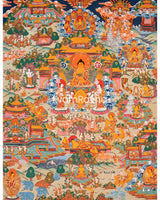
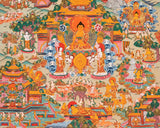
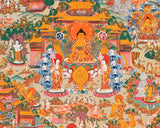
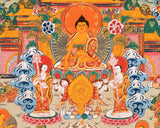
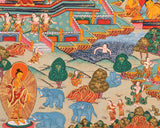
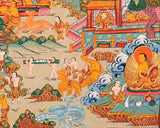
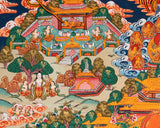
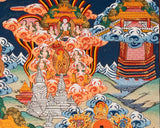
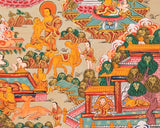
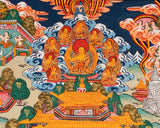
Vintage Buddha Life Story | Wall Decoration Painting
Vintage Buddha Life Story
What is a Thangka painting?
The Tibetan word Thangka means an unfolding painting, where the word Thang stands for an unfolding scroll and Ka means a painting. Thangka paintings, as a whole, are a visual representation of Buddhist deities, scenes, or mandalas, painted on silk or cotton canvas.
Thangka Paintings follow a generic principle of composition, design, and iconography. It is made following tradition and guidelines while leaving spaces for personal creativity and expression. In Buddhist culture, Thangka Paintings hold high religious values. In a way, it is also a tool that facilitates the realization of one's true nature or the nature of reality
Introduction to Shakyamuni Buddha
A rare Vintage Thangka procured in the 1980s, perfectly maintained and kept for all these years, is available for you.
Shakyamuni Buddha is depicted in this thangka together with the two main disciples as it appears in the most classical representations.
Buddha is seated in vajra posture on a white moon disc and lotus.
Shakyamuni Buddha was an educator upon whose lessons the establishments for Wholesome Dharma were shaped. He is respected as the Supreme Buddha and is the primary edified person to be idolized walking on Two Legs.
Despite confusion from those who don't take after Buddhism, it is critical to note that the Buddha was not considered a God. He was a simple human, just like the rest of us, who was able to create an uncommon discernment around his presence.
------------------------------------------------------------------
Size: 15"/ 38 cm (width) x 20"/ 51 cm (height)
Materials: Cotton Canvas, Acrylic Colors, Genuine 24K Gold
------------------------------------------------------------------
THIS THANGKA IS HAND-PAINTED IN THE TRADITIONAL STYLE BY NEPALI ARTIST AND THE QUALITY IS HIGH
------------------------------------------------------------------|
How to take care of your thangka?
-Regular Inspection of your thangka; examine the borders and all attachments.
-Keep thangkas covered when they are on display but not in use.
-Rotate thangkas between display and storage regularly, two to four times a year, to reduce the amount of exposure to light. Keep away from sunlight and humidity.
-Do not apply liquids or other materials to the surface of the thangka.
Shipping & Returns
Row content
Compatibility
Row content
















